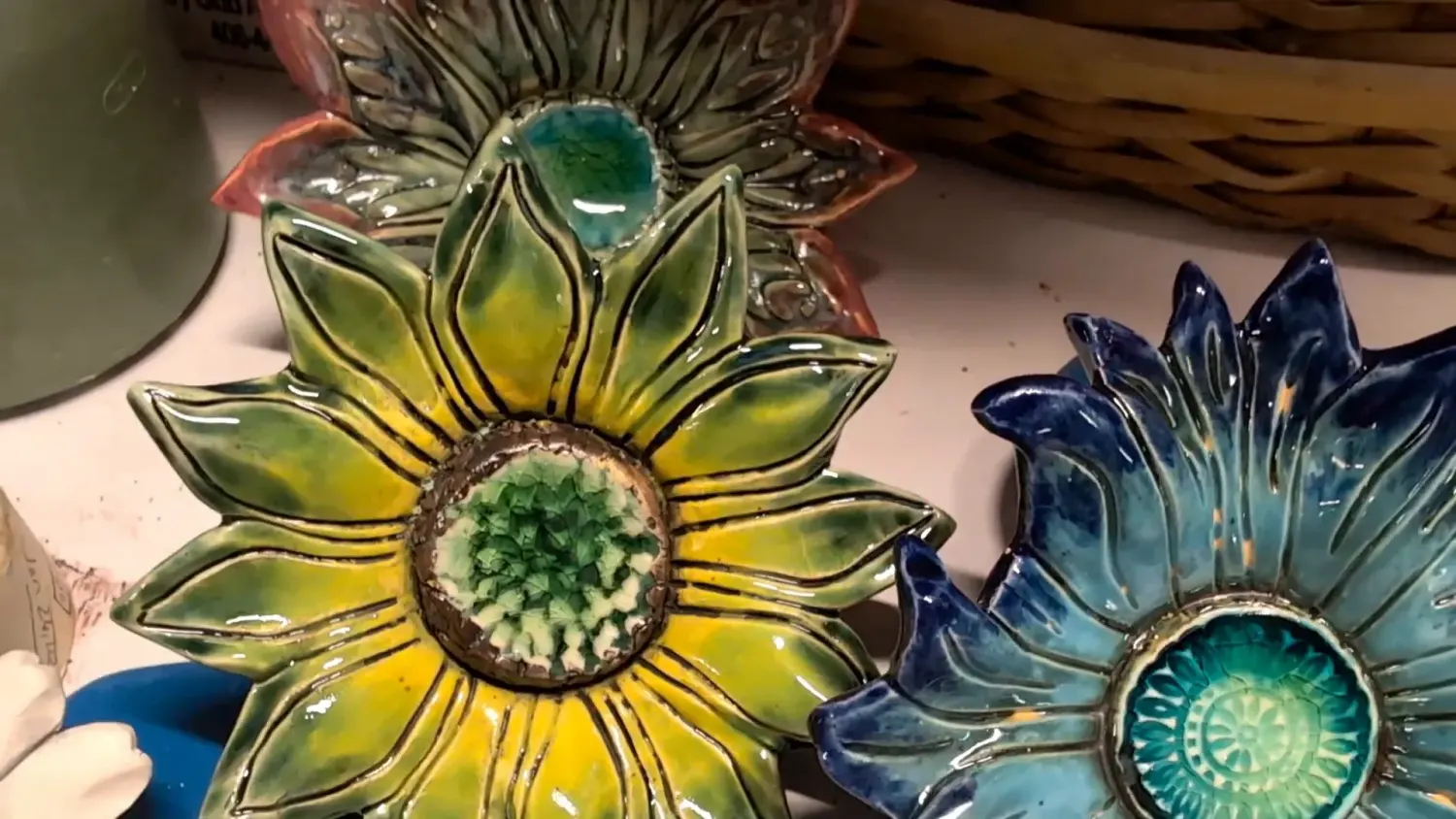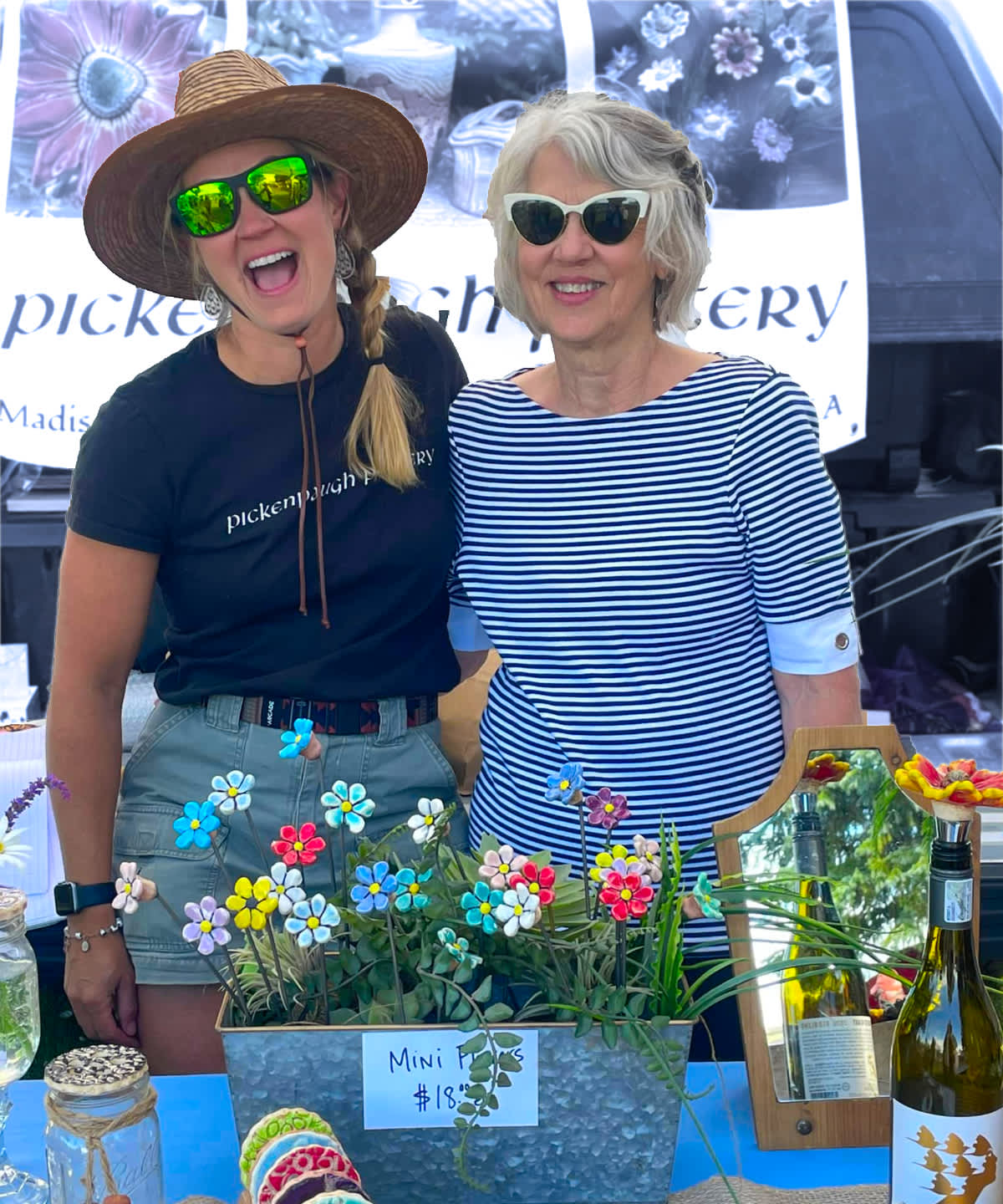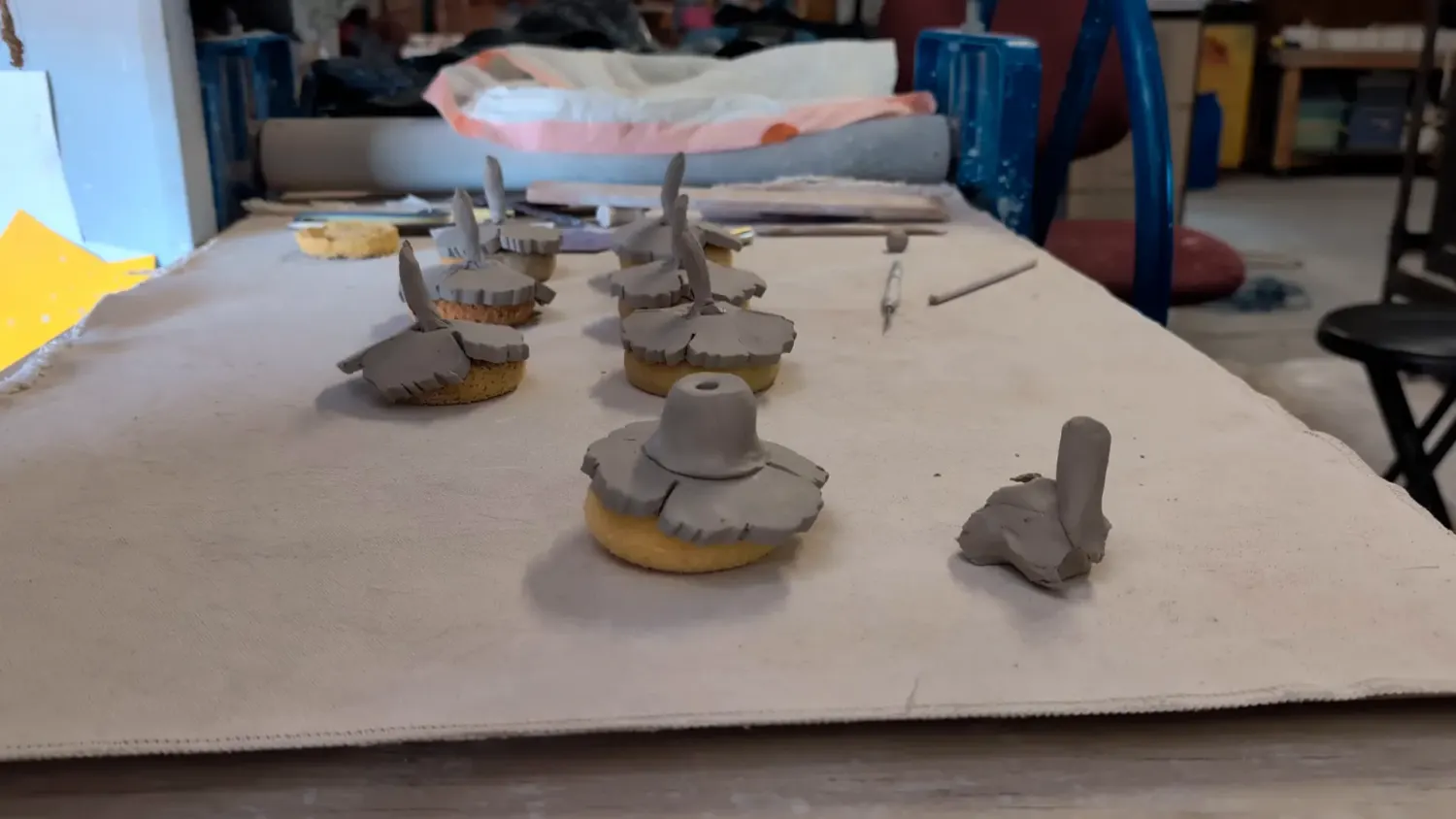


In a world where artists often wrestle with doubts about their chosen path, the story of Merry Pickenpaugh and her daughter MerryCline Pickenpaugh from Pickenpaugh Pottery shines as a beacon of resilience, creativity, and business savvy. This mother-daughter duo has nurtured a multigenerational pottery business in Madison, Mississippi, for over fifty years, evolving with the times while staying deeply rooted in their craft and community.
Through their candid conversation with Kay Potter, we get an intimate glimpse into the heart of their family business, their artistic processes, and the practical lessons they've learned about connecting with customers, pricing art, and thriving in the competitive world of art markets. Whether you're a seasoned artist or just starting out, their insights offer invaluable guidance on balancing passion with profitability and building a sustainable creative enterprise.
Pickenpaugh Pottery began fifty-one years ago, founded by Merry Pickenpaugh and her husband Robert Pickenpaugh. Nestled in Madison, Mississippi, the pottery studio has become the oldest business in their town, a testament to their enduring passion and commitment. Over the decades, the business has grown into a family affair, with MerryCline, their daughter, joining the legacy alongside other family members.
What makes Pickenpaugh Pottery truly remarkable is not just the longevity of the business, but the way it has evolved. They have continually adapted their offerings to meet changing tastes and market demands, all while preserving the essence of handmade, quality pottery. The family's approach blends traditional techniques with personal, meaningful customization that resonates deeply with their customers.
At the core of Pickenpaugh Pottery's success is their artistry, which is both inspired and inspiring. Merry Pickenpaugh delights in creating unique Santa Claus pieces that break away from the typical mold. Her Santas are not just seasonal decorations—they are stories molded in clay. For example, one Santa incorporated lace from a customer's mother's wedding veil, delicately pressed into the clay to preserve a cherished family memory. Another featured tiny charms made from jewelry, turning the piece into a wearable story of personal history.
Merry's approach to these custom Santas is fluid and deeply personal. She draws inspiration from the people who commission the pieces, their stories, and their memories. This transforms each creation into a one-of-a-kind work of art that holds sentimental value beyond its aesthetic appeal.
Meanwhile, MerryCline Pickenpaugh specializes in delicate pottery flowers designed to brighten gardens everywhere. Her Valentine's rose, for example, is a labor of love, with each petal carefully stamped, rolled to a thin tip, and spiraled into a lifelike bloom. These flowers are crafted to endure outdoor conditions, becoming lasting accents in homes and gardens.
Both artists demonstrate how pottery can serve as a medium for storytelling and personal expression, whether through meaningful customization or nature-inspired designs.

One of the most insightful parts of their discussion centers on balancing what sells with what inspires. Merry emphasizes that she creates what she wants to make, exploring new ideas and designs without the pressure of commissions. However, MerryCline, who is at a different stage in her life, acknowledges the practical need to produce items that sell consistently to support her family.
She explains her weekly routine, dedicating certain days to creating affordable, popular pieces—priced between $20 and $60—that appeal to a broad customer base. Then, she reserves separate time for larger, more complex pieces that reflect her artistic vision and passion, which can sell for much higher prices. This balance allows her to maintain financial stability without sacrificing creative fulfillment.
"On a realistic everyday artist level, that's not reality. Reality is balancing what sells and what you wanna make." — MerryCline Pickenpaugh
This pragmatic approach highlights an important lesson for artists: success often requires flexibility and the ability to cater to different market segments while nurturing personal artistic growth.
For many artists, knowing when a piece is finished—or when to let it go despite imperfections—is a significant challenge. Merry and MerryCline share candid reflections on this topic, revealing their own struggles with self-criticism and perfectionism.
Merry does not take commissions for the custom Santas, allowing herself the freedom to be inspired without the pressure of deadlines or expectations. Both artists admit that not every piece will be perfect, and that sometimes they must accept "seconds"—pieces with minor flaws that customers often do not notice.
They rely on trusted friends and fellow artists to provide honest feedback, helping to gain fresh perspectives and avoid getting stuck in endless self-critique. This external input is crucial for moving forward and maintaining productivity.
Learning to release a piece that isn't flawless but still has value is a vital skill that protects artists from burnout and encourages continuous creation.
Building lasting relationships with customers is a cornerstone of Pickenpaugh Pottery's success. Merry and MerryCline emphasize the importance of genuine, educational interactions rather than high-pressure sales tactics.
When customers approach their booths or gallery, they start with simple greetings like, "Thank you for coming to the show," or "How's your day going?" These openers invite conversation without making visitors feel pressured.
They also focus on educating potential buyers about the pieces—sharing the stories, techniques, and inspiration behind the art. This approach helps customers connect emotionally with the work and understand its value.
Reading the customer's cues is another key skill. Some people want to chat and learn, while others prefer to quietly browse. Respecting those boundaries builds trust and creates a welcoming atmosphere.
"Educate them on the product itself... so that they can see, okay, this is what kind of the standard is for your art your type of art." — MerryCline Pickenpaugh
For artists who feel shy or unsure about engaging with customers, Merry and MerryCline suggest starting with easy, friendly questions and letting the conversation flow naturally. Over time, this practice builds confidence and can lead to more meaningful connections and sales.

One of the most practical tips shared is the critical importance of booth setup in art markets. MerryCline stresses that if you don't get people into your booth, you won't make sales.
Key elements of an inviting booth include:
She recalls feedback from customers calling her booth a "fairy garden," which drew many people in and sparked conversations. Thoughtful booth design is not just about aesthetics—it's about creating an experience that invites exploration and connection.
For artists new to markets, Merry and MerryCline offer sage advice: visit the market before signing up. This simple step allows you to:
They liken it to going on a blind date—you want to know who you're meeting before committing. Visiting beforehand reduces surprises and helps you prepare appropriately, from choosing inventory to dressing for the occasion.
Pricing is often one of the toughest aspects of running an art business. Merry and MerryCline emphasize that handmade pottery and art should never be priced like mass-produced goods.
They share a powerful anecdote about how customers often choose the more expensive piece because they sense the artist values it more. Pricing too low can unintentionally signal lower quality or less artistic worth.
"Don't put China prices on them... When I see two pieces and this one's more, I think, oh, the artist liked this one better. I'm gonna pay the extra for this one." — Merry Pickenpaugh
They encourage artists to be confident in their pricing, reminding customers that the cost reflects the time, skill, and passion invested. Comparing art to everyday expenses like meals or groceries helps put pricing in perspective.
Moreover, they advise not to be discouraged by price objections. Not every customer will be the right fit, and that's okay. Maintaining your price communicates the value of your work and attracts buyers who appreciate it.
While Pickenpaugh Pottery started in an era before social media, they've adapted to the digital age without losing the personal touch that made them successful. They've found that social media often complements word-of-mouth marketing, enabling customers to discover their work online and then visit in person.
They stress that having a loyal, engaged community is more valuable than chasing large numbers of followers. A smaller group of passionate supporters who return and spread the word sustains long-term success.
Despite the challenges of managing multiple communication channels, they make an effort to stay connected through phone, email, Facebook, and in-person interactions. This multi-pronged approach ensures customers can reach them in the way that's most comfortable.
After more than five decades, Merry and MerryCline embody a continuous learner's mindset. They openly acknowledge that not every year has been a success, and that the art business involves ups and downs.
They encourage artists to embrace struggle as part of growth, to keep experimenting, and to ask for feedback—even if it's hard to hear. This willingness to evolve, pivot, and innovate has enabled Pickenpaugh Pottery to thrive through changing times.
As MerryCline puts it, "We haven't just made bowls and plates and mugs for fifty-one years. We're making Santas. We're making fish. We're making all kinds of stuff, flowers. We're rolling with the punches."
This adaptability, combined with a strong foundation of craftsmanship and community, is the secret to their longevity.
To those considering entering art markets or growing their creative business, Merry and MerryCline offer heartfelt advice:
They conclude with a powerful reminder that resonates deeply with every artist:
"When are you gonna get a real job?" was asked of Robert fifty-one years ago. Today, Pickenpaugh Pottery is the oldest business in Madison, Mississippi. It will come—whether quickly or slowly—but have confidence and enjoy what you do."

The story of Merry and MerryCline Pickenpaugh is more than a tale of pottery; it's a lesson in resilience, family, and the intertwining of art and commerce. Their journey teaches us that creating art is not just about the solitary act of making, but about building relationships, understanding your market, and constantly evolving.
For artists looking to build sustainable businesses, their advice offers a roadmap grounded in real-world experience and heartfelt passion. From the delicate petals of a handcrafted rose to the whimsical charm of a custom Santa, Pickenpaugh Pottery exemplifies how artistry and entrepreneurship can flourish hand in hand.
May their story inspire you to take that first step, trust your craft, and build a creative business that lasts a lifetime.



© 2024 The Artist's Guide to Business. All rights reserved.
Privacy Policy
Terms of Service
Cookies Settings
